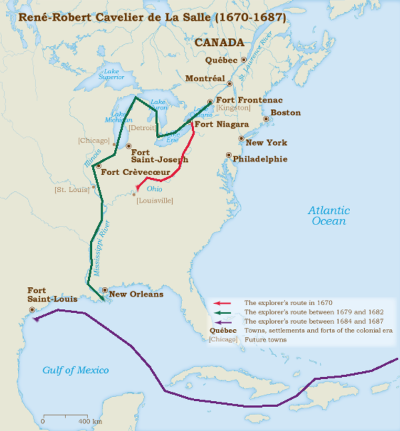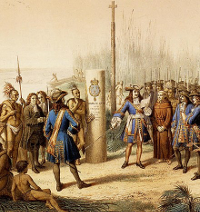French explorer René-Robert Cavelier, Sieur de La Salle was the first European to travel the entirety of the Mississippi River, achieving the feat in 1682. He was also the creator of the name Louisiana for the vast territory that later became part of the U.S. La Salle was born on Nov. 21, 1643, at Rouen, in Normandy, in what is now France. His family was well-to-do. 
When he was 15, he enrolled as a novice in the Jesuit faith in Rouen; two years later, he took the vows of a priest. He found the call of adventure irresistible and left the faith in 1667. La Salle followed his brother, Jean, to New France in 1667 and gained a land grant of 400 acres, which he named Lachine, the French word for China (a land he kept trying to travel to in later years). He learned the language of the Iroquois, the local Native Americans, who described to him the Ohio River, a waterway that flowed into the large Mississippi. La Salle believed that by traveling via those rivers, he could find a way to California and, finally, to China. In 1669, he set out on the first of several expeditions westward, starting at Quebec and then going on or along Lake Erie and Lake Ontario. On this expedition, in Hamilton, Ontario, he met two other famous French explorers, Father Jacques Marquette and Louis Jolliet. La Salle and his men found the Ohio River and followed it as far as Louisville before encountering an all-too-common problem suffered by explorers, desertion. He returned to Montreal. Back home, La Salle helped construct Fort Frontenac, on Lake Ontario's eastern coast; the fort's name came from Louis de Baude Frontenac, New France's governor-general. 
French King Louis XIV granted La Salle permission to explore the lands between Florida, Mexico, and New France. La Salle, his friend Henri de Tonty, and others built Fort Conti on the Niagara River and the sailed across Lake Erie and Lake Huron before going by land to Lake Michigan and then across it, reaching what is now Green Bay, Wisc. The men built Fort Miami at the mouth of the Miami River in January 1680 and spent several most of the year there. Carrying on in December, they reached what is now Peoria, Ill., and built Fort Crevecoeur. La Salle had become successful in the fur trade, but he still burned for something bigger. He sailed for home to implore his king to task him with a new purpose. Louis XIV charged La Salle with sailing down the Mississippi River to the Gulf of Mexico. He did so, becoming the first European to accomplish the feat in 1682 and naming the very large area Louisiana, in honor of his king. Along the way, he and his party built Fort Prud'homme, where Memphis, Tenn., now is. He reached the Gulf of Mexico and claimed the area in Louis' name (La Louisiane) on April 9, 1682. The return journey was difficult, as the party suffered from illness and attacks by hostile Native Americans. Along the way, they built Fort St. Louis in Illinois.
La Salle sailed home in 1683 but stay long, returning the following year with a large number of would-be colonists. The enterprise was beset by problems at every step of the way: one of the ships got lost at sea, the surviving ships landed at a spot 500 miles west of their target (at Matagorda Bay, near what is now Houston) and one ship ran aground, and then the settlers suffered through an armed conflict with local Native Americans. The settlement efforts succeeded somewhat, with a fort at the mouth of the Lavaca River. But things went downhill from there. One ship and crew returned to France, and a pilot wrecked the other. A group of 20 set out on a quest to find the Mississippi River and try to reverse La Salle's 1682 journey. A dozen of these men died on the way, and the other eight returned to their Lavaca River fort in October 1686. La Salle set out again early the following year, this time with 24 other men, including a few who had remained to guard the fort. The second expedition had no more success than the first; in the end, La Salle died at the hand of his own men, who turned on him near Navasota, Texas, on March 19, 1687. They left him behind and succeeded where he had failed, arriving in Montreal the following year. |
|
Social Studies for Kids
copyright 2002–2025
David White





